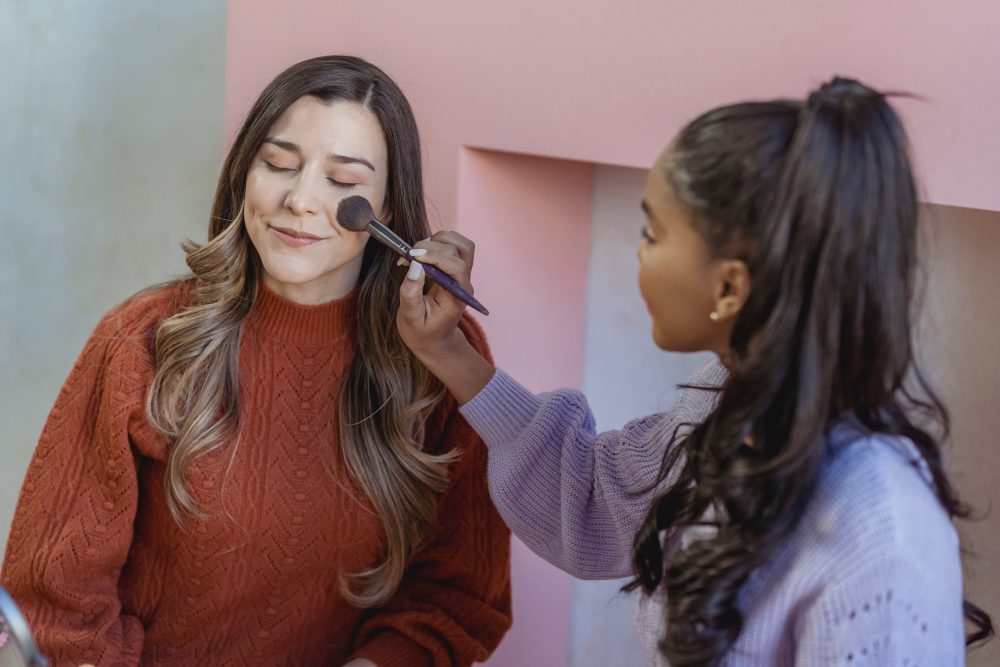
We’ve all been there – you spend precious time perfecting your makeup, only to catch a glimpse in the mirror and discover a cakey cakey makeup look that resembles more of a crumbly pastry than a flawless face. Fear not, for achieving a smooth complexion is an art, and the secret lies in the details of your makeup routine.
To achieve perfect complexion, the devil is in the details. Hydration, primer, mindful foundation application, and strategic powder usage are the cornerstones of cakey makeup.
What Causes Cakey Makeup?
Cakey makeup occurs when the application and formulation of makeup products result in a thick, textured appearance on the skin.
- Dry or Dehydrated Skin: Makeup tends to cling to dry patches or dehydrated skin, emphasizing uneven textures. Proper hydration is crucial for a smooth canvas. Using a good moisturizer before applying makeup helps create a more even surface.
- Excessive Product Application: Overusing makeup products, particularly foundation and concealer, can lead to a heavy and cakey finish. Applying more product than necessary can overwhelm the skin, making it difficult for the makeup to blend seamlessly.
- Incorrect Primer Usage: While primers are excellent for creating a smooth base, using the wrong type of primer or applying too much can contribute to a cakey appearance. Choose a primer that suits your skin type and apply it sparingly to avoid product buildup.
- Incompatible Product Formulas: Mixing incompatible formulas, such as combining water-based and oil-based products, can lead to a cakey result. It’s essential to choose products with compatible formulations to ensure they work well together on the skin.
- Incorrect Foundation Shade: Using a foundation that is too light or too dark for your skin tone can result in an unnatural, cakey appearance. Always choose a foundation shade that matches your skin tone to achieve a seamless blend.
- Powder Overload: Setting powders are crucial for preventing makeup from sliding off, but applying too much or using a powder with a heavy texture can contribute to a cakey look. Use a light hand when applying powder, focusing on areas prone to oiliness or creasing.
- Incorrect Makeup Order: Applying makeup in the wrong order, such as applying creams over powders, can disrupt the makeup’s texture and lead to a cakey finish. Follow the correct order: liquids, creams, powders, to ensure each product sets properly.
- Lack of Blending: Inadequate blending is a common cause of cakey makeup. Whether it’s foundation, concealer, or other products, taking the time to blend thoroughly ensures a seamless, natural appearance. Use makeup tools like brushes or sponges for a smoother finish.
- Environmental Factors: Humid or dry weather conditions can affect how makeup sits on the skin. Adjusting your makeup routine based on the weather can help prevent cakey makeup. For example, using a mattifying primer in humid conditions can help control excess oil.
- Skipping Skincare Steps: Neglecting proper skincare, especially moisturizing, can contribute to a cakey makeup look. Well-hydrated and well-prepped skin provides a smoother canvas for makeup application.

Tips To Avoid Cakey Makeup Look
Let’s explore some tips to keep your makeup game strong without falling into the dreaded cakey looking makeup trap.
Hydration is the Foundation
Just as a well-watered garden flourishes, your skin needs hydration for makeup to glide on seamlessly. Start with a good moisturizer to create a smooth canvas. Dry patches are like potholes on the road to a flawless finish, so ensure your skin is well-hydrated.
Primer: The Unsung Hero
Consider primer your makeup’s best friend. It not only extends the life of your makeup but also creates a smooth surface. Opt for a primer that suits your skin type – whether it’s mattifying, hydrating, or pore-filling – to ensure your makeup has a solid foundation to cling to.
Less is More – Foundation Edition
Building layers of foundation may seem like a good idea for coverage, but it’s a shortcut to Cakeyville. Use a light hand, and choose a foundation that matches your skin tone. Blend it thoroughly to avoid any demarcation lines, allowing your natural skin to shine through.
Concealer Precision
Concealer is the superhero that tackles blemishes and dark circles. However, too much of a good thing can be bad. Apply concealer sparingly, focusing on the areas that need coverage. Dab and blend, but resist the urge to create a thick mask – your skin will thank you.
Powder Power – but with Caution
Setting powder is a makeup essential, but it can quickly turn into a villain if applied excessively. A light dusting is all you need to set your makeup. Pay attention to areas prone to creasing, like the under eyes, and steer clear of piling on too much powder – unless you’re aiming for the ghostly chic look.
Layering with Finesse
If you’re a fan of layering makeup, be strategic about it. Allow each layer to set before moving on to the next. Creams before powders, and liquids before creams – it’s a delicate dance that prevents your makeup from clashing and creating a cakey disaster.
The Finishing Touch – Setting Spray
A spritz of setting spray not only helps set your makeup but also melts everything together for a more natural finish. Choose a setting spray that aligns with your desired finish – dewy or matte – to lock in your look.
Sign Up to Our Newsletter
Get notified about exclusive offers every week!

